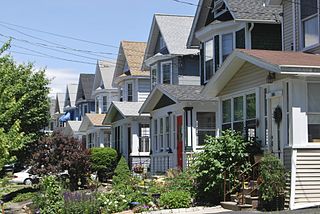
Albany is the capital and oldest city in the U.S. state of New York, and the seat of and most populous city in Albany County. It is located on the west bank of the Hudson River, about 10 miles (16 km) south of its confluence with the Mohawk River.
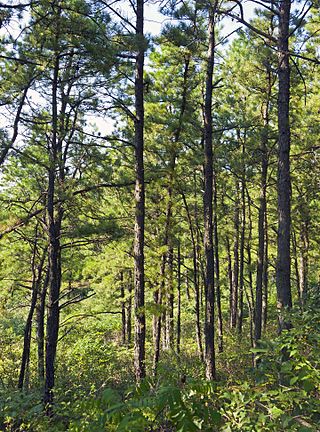
The Albany Pine Bush, referred to locally as the Pine Bush, is one of the largest inland pine barrens in the world. It is centrally located in New York's Capital District within Albany and Schenectady counties, between the cities of Albany and Schenectady. The Albany Pine Bush was formed thousands of years ago, following the drainage of Glacial Lake Albany.
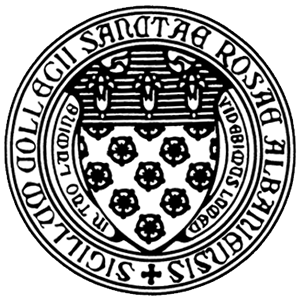
The College of Saint Rose was a private Catholic college in Albany, New York. It was founded in 1920 by the Sisters of St. Joseph of Carondelet as a women's college. It became fully co-educational in 1969. The following year, the college added laypersons to its board and became an independent college sponsored by the sisters. The college was in the Pine Hills neighborhood of Albany. It was a Division II member of the National Collegiate Athletic Association (NCAA).

The neighborhoods of Albany, New York are listed below.
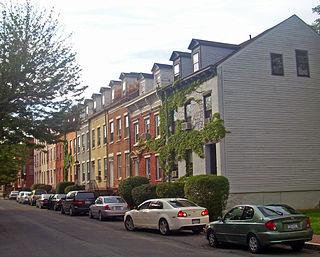
The Pastures Historic District is a residential neighborhood located south of downtown Albany, New York, United States. Its 17 acres (6.9 ha) include all or part of a 13-block area.

The Mansion Historic District, sometimes referred to as Mansion Hill, is located south of Empire State Plaza in Albany, New York, United States. It takes its name from the nearby New York State Executive Mansion, which overlooks it. It is a 45-acre (18 ha), 16-block area with almost 500 buildings. Many of them are rowhouses and townhouses built in the middle and late 19th century that remain mostly intact today.
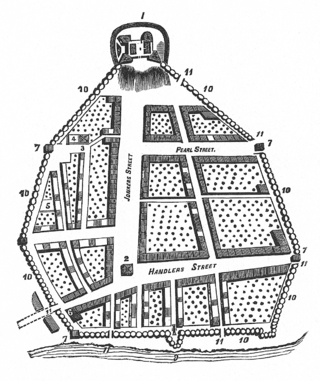
The streets of Albany, New York have had a long history going back almost 400 years. Many of the streets have changed names over the course of time, some have changed names many times. Some streets no longer exist, others have changed course. Some roads existed only on paper. The oldest streets were haphazardly laid out with no overall plan until Simeon De Witt's 1794 street grid plan. The plan had two grids, one west of Eagle Street and the old stockade, and another for the Pastures District south of the old stockade.

Arbor Hill is a neighborhood in Albany, New York, generally defined as the area from Clinton Avenue north to Tivoli Hollow and the Livingston Avenue Railroad Bridge and from Broadway west to Henry Johnson Boulevard. Both Clinton Avenue and Henry Johnson Boulevard are signed as U.S. Route 9. It was outside Albany's first boundaries as set up in the Dongan Charter of 1686. The original name of the area was Colonie, and the area was incorporated under that name as a village in 1804; it was annexed by Albany in 1815. There are two sub-neighborhoods in Arbor Hill, Dudley Heights and the Ten Broeck Triangle. "Arbor Hill" was the name given to the Ten Broeck estate; the Ten Broeck Mansion is still an important cultural and historical museum. The neighborhood has other historical and cultural sights such as the Palace Theatre and St. Joseph's Church. Demographically it is predominantly African-American.
McKownville is a hamlet in the town of Guilderland, Albany County, New York, United States. It lies along the eastern border of the town with the city of Albany. McKownville is a heavily developed suburb of Albany and is home to many strip malls, shopping centers, and a portion of the University at Albany, SUNY and is bisected by U.S. Route 20. McKownville is named for John McKown and family, early settlers from the late 18th century.

The W. Averell Harriman State Office Building Campus is an office park in western Albany, New York, United States that houses sixteen New York State Government office buildings. The land totals roughly 330 acres (130 ha) and over 3 million square feet of office space, and about 7,000 state employees work there. The campus was built during the 1950s and 1960s in a suburban, car-oriented style bordered by an outer ring road that cuts the campus off from the surrounding neighborhoods. The campus is flanked by Washington Avenue to the north, Western Avenue to the south, University at Albany to the west, and New York State Route 85 to the east. With its own steam generation power plant for cooling and heating the campus is mostly self-sufficient.
Woodlawn is a neighborhood of Schenectady, New York, United States, which occupies the entire southeastern section of that city. The neighborhood developed as a suburb of the city of Schenectady in the first two decades of the 20th century and was annexed to the city in 1923. Consisting of mostly single family detached houses it is only one of three neighborhoods in Schenectady to post an increase in population during the 1990s; Woodlawn's median population is also the oldest of Schenectady's neighborhoods.

Downtown Schenectady is the central business district for the city of Schenectady, New York. It originated in the 1820s with the moving of the commercial and industrial interests east from the original 17th and 18th century settlement, spurred on by the development of the Erie Canal. Home to the headquarters and major manufacturing plants of two large corporations, General Electric and American Locomotive Company, Downtown Schenectady catered to tens of thousands of workers in its heyday. Typical of the post-industrial Northeastern United States and Upstate New York in particular, Downtown Schenectady saw a decline in manufacturing and population starting in the 1970s. Recent construction and renovation has caused the downtown area to become an entertainment mecca for New York's Capital District anchored by Proctor's Theatre.
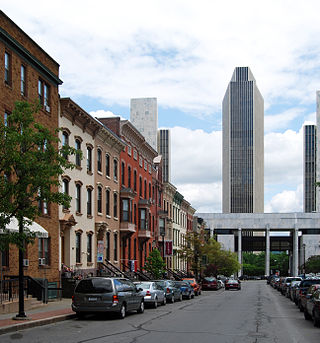
The architecture of Albany, New York, embraces a variety of architectural styles ranging from the early 18th century to the present. The city's roots date from the early 17th century and few buildings survive from that era or from the 18th and early 19th century. The completion of the Erie Canal in 1825 triggered a building boom, which continued until the Great Depression and the suburbanization of the area afterward. This accounts for much of the construction in the city's urban core along the Hudson River. Since then most construction has been largely residential, as the city spread out to its current boundaries, although there have been some large government building complexes in the modernist style, such as Empire State Plaza, which includes the Erastus Corning Tower, the tallest building in New York outside of New York City.

North Albany is a neighborhood in the city of Albany, New York. North Albany was settled in the mid-17th century by the Patroon of Rensselaerswyck and his tenants and later became a hamlet in the town of Watervliet. Due to the Erie Canal being constructed in 1825, North Albany saw immense growth, with the Albany Lumber District and an influx of Irish immigrants lending the area the name of Limerick. Home to many historic warehouses and row houses, North Albany continues to be an important industrial neighborhood. Recent efforts have begun to gentrify the neighborhood by adapting heavy industry/warehouse use to artistic and entertainment venues, such as a German beer garden, an amusement park, live music venues, and arts and crafts marketplaces.

Sheridan Hollow is a neighborhood in Albany, New York located in a ravine north of Downtown Albany. Capitol Hill to the south and Arbor Hill to the north flank the ravine. Often the neighborhood is overlooked by city residents, and outsiders who work in the neighborhood often don't recognize the name of the neighborhood. This is due to the identity of the Hollow being subsumed into its larger neighbor Arbor Hill, for instance news stories of events are often accredited to the wrong neighborhood. Being on undesirable land for development in colonial times, growth was slow in the Hollow and the neighborhood was populated through the centuries by a series of ethnic groups new to Albany, such as the Irish, Polish, and African Americans.
The Tivoli Nature Preserve, also Tivoli Park, in Albany is the largest urban nature preserve in the Capital District.

Townsend Park is a small urban park in Albany, New York, New York State, United States. It encompasses a triangle of land formed by the Y-intersection of Central and Washington avenues, with the third (western) border formed by Henry Johnson Boulevard.

Dana Park is a small .2-acre (810 m2) urban park in Albany, New York and includes a memorial to James Dana which doubles as Albany's last remaining horse trough. It is located in the Y-intersection caused by Delaware Avenue to the east and Lark Street to the west, with the third leg of the triangle formed by Dana Avenue. Madison Avenue forms a five-point intersection with Lark Street and Delaware Avenue at the eastern end of the park. The park is important to several different neighborhoods, Hudson-Park, Park South, and Lark Street.

Bleecker Park is a small .37-acre (0.15 ha) urban park in Albany, New York. The park is triangle-shaped, bounded by Madison Place to the south, Madison Avenue to the north, and Eagle Street to the west. The Cathedral of Immaculate Conception is across Eagle Street from the park, while Madison Place, which is only one block-long, consists of rowhouses primarily in High Gothic and Italianate architecture, built in the mid-to-late-19th century. Across from the park on Madison Street is the Empire State Plaza East Parking Garage, built in 1999/2000. The park features the oldest fountain in the city which is surrounded by a small circular garden, two circular beds are also in the park and each feature a shrub surrounded flowers, these small gardens make Bleecker Park "a most charming and restrained Victorian public garden" according to an article in the Albany Times Union.



















